 Abraham Lincoln
If given the truth, the people can be depended upon to meet any national crisis...
Abraham Lincoln
If given the truth, the people can be depended upon to meet any national crisis...
 Guildford news...
for Guildford people, brought to you by Guildford reporters - Guildford's own news service
Guildford news...
for Guildford people, brought to you by Guildford reporters - Guildford's own news service
Book Review: Seventy Years Of The South Western
Published on: 27 Jul, 2022
Updated on: 27 Jul, 2022
 By David Rose
By David Rose
The first railway company to open a line to Guildford was the London & South Western (LSWR) The line arrived from Nine Elms via Woking Common in 1845. Further lines soon followed from all points of the compass.
The railway soon led to much development as the town grew rapidly. Today Guildford station is a railway hub and the so-called Portsmouth Direct line from London Waterloo station to the south coast is a busy line indeed.
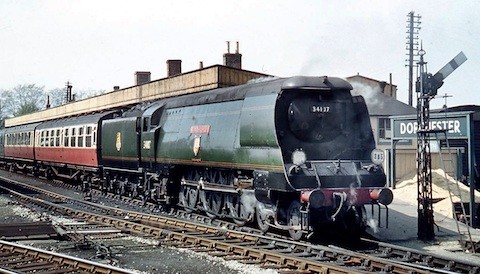
Bullied pacific 34107 Blandford (later renamed Blandford Forum at the local council’s request) at Dorchester South in April 1952.
Just published is a fantastic book, Seventy Years Of The South Western, that tells the story of railway lines from London Waterloo to the south and south-west of England, other local lines connecting places in Surrey and suburban London, plus the fondly remembered Somerset & Dorset line, and even today’s heritage line – the Swanage Railway.
Its author, Colin Boocock loves railways. His earliest memories of trains date back to the 1940s. He is a retired railway officer whose career, mainly in mechanical and electrical engineering, spanned 41 years with British Railways, Railtrack and part-time consultancy work.
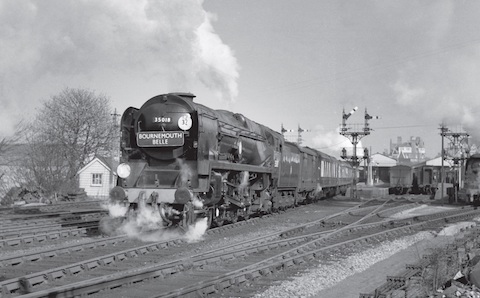
In the days of steam, one of the most famous trains on the South Western was the Bournemouth Belle, seen here departing from Bournemouth West station.
His knowledge of this complex railway system is extensive and his book is full of details that are clear to read and understand. Plus, it has lots of superb vintage and modern photos, many he has taken himself.
The book looks at the past 70 years, from nationalisation in 1948 to form British Railways through to the privatisation of Britain’s railways, when Stagecoach and South West Trains came on the scene in 1996, being replaced by today’s South Western Railway in 2017.
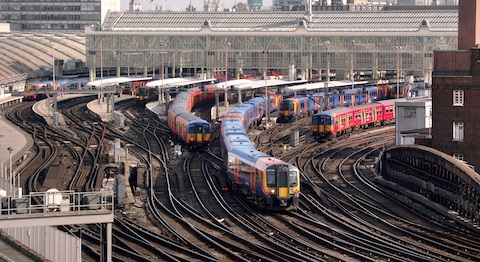
Waterloo is London’s busiest terminus station.
One particularly fascinating chapter, titled An Amazing Terminus, details the story of London Waterloo station. The author brings it right up to date with the latest electric multiple unit trains.
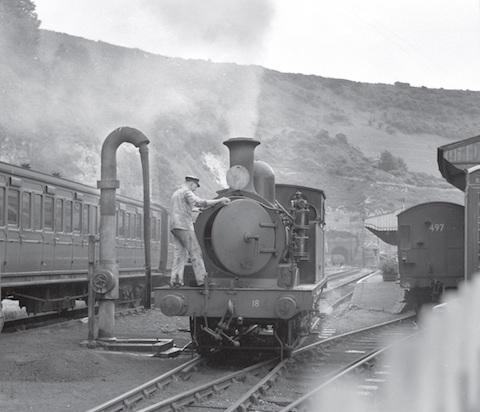
Ventnor station on the Isle of Wight.
The book also looks at the history of the railways on the Isle of Wight and the former branch line to Hayling Island. I bet people have memories of using those when going on holiday!

Effingham Junction, June 3, 1985.
Throughout the book the author exquisitely describes the routes of the lines he writes about. For example, from Woking on through Guildford and beyond he notes: “If we join the Portsmouth fast service today, we can enjoy for the next fifty minutes or so what seems a rather leisurely journey through pleasant countryside and deciduous woodlands. It is firstly a short hop to Guildford, the largest town on this stretch of the railway with its 1960s red brick cathedral. Its station is sandwiched between two junctions to the north and a tunnel at the south end.
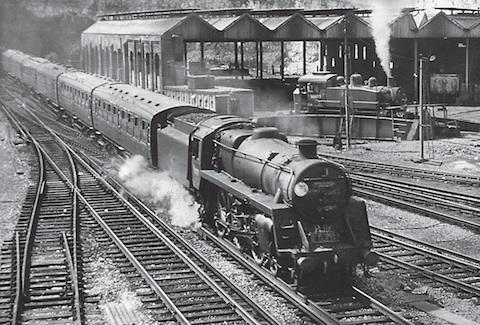
The last day of steam on the Southern Region, July 9, 1967, and BR Class 5, 73029 passes Guildford’s motive power depot with empty carriage stock from Fratton to Clapham Junction. The loco on the turntable is USA class tank engine, 30072. It would shortly be the last engine to leave the depot for Salisbury. It lives on today at the Keighley & Worth Valley Railway.
“Guildford used to be served by a steam locomotive depot in a tight space on its west side. The covered part of this depot included a semi-roundhouse with the stabling tracks linked to the outside world by a turntable.
“After the tunnel and the junction at Shalford, the Direct line undulates with an average uphill trend until Godalming and Milford, beyond which our train faces four miles of 1 in 80 to its summit at the well-heeled town of Haslemere. Then it’s downhill, not quite as steeply but with curves that prevent unbounded fast running down to Liss.”
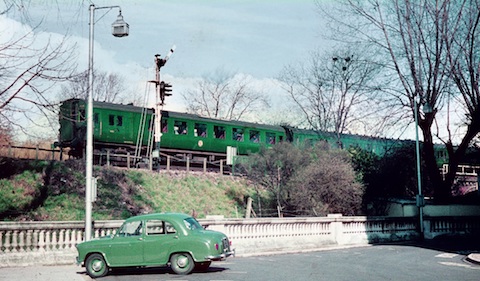
A Portsmouth Harbour-bound express electric train passes behind Portsmouth College on October 15, 1960.
The penultimate chapter is titled Who Owns It Now? Here the author explains how the change from public to private ownership in the region came about and what happened to the rolling stock, while commenting on those changes.
For example, he writes: “In 1996, Stagecoach’s South Western Trains franchise took over all train services out of London Waterloo terminus. As with other franchises, it was constrained by the service commitments it had entered into as part of the franchise agreement. It did use its initiative a bit, particularly during the short period when SWT ran a service of four trains an hour between Waterloo and Southampton Central. That proved to be a little over-the-top and was soon thinned out.
“By leasing trains, SWT was able to meet the Government’s franchise requirement to get rid of slam-door stock. The class 442 fleet was owned by Angel Trains as are the 444 and 450 fleets…”
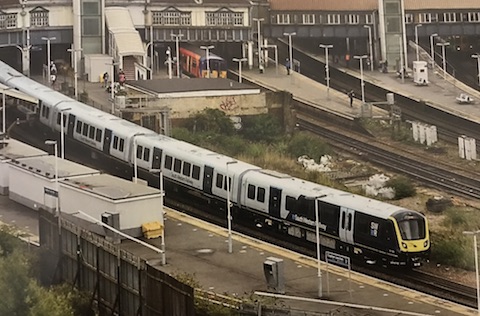
A new class 701 electric multiple unit in the latest South Western Railway livery.
The final chapter looks to the future and the author writes that he believes now (after passenger numbers fell during the recent pandemic) they will rise again, “perhaps slowly, to much the same levels as before, though London commuting may take much longer to reach high levels.”
He ends by saying: “I doubt if I will be around to re-read this chapter to see what really happens in the next 20 years, but if I do reach 104…. then maybe!”
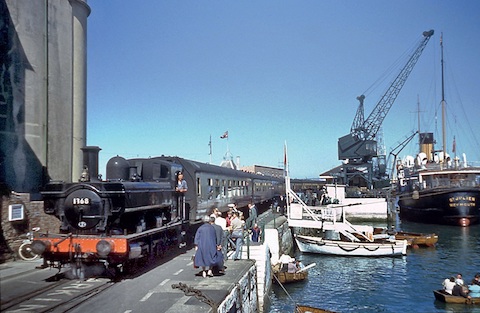
The railway line to Weymouth Quay as a tramway with former Great Western Railway pannier tank engine, 1368, in July 1959.
A few facts about “The South Western” include: It was the last railway in the UK to operate main line express trains with steam locomotives, continuing with steam until July 1967.
It ran one of the most exciting main lines for steam train performance in the hilly but speedy Atlantic Coast Express route to Exeter.
It once owned some of the busiest docks in the UK at Southampton.
Today it is a partner with other railways in Britain’s busiest interchange station, Clapham Junction.
This is a great railway book, much unlike any other I have read.
Seventy Years Of The South Western is a hardback book of more than 230 pages, with black and white and colour photographs and maps and costs £35. Published by Pen & Sword Books. Website: www.pen-and-sword.co.uk
Responses to Book Review: Seventy Years Of The South Western
Leave a Comment Cancel replyPlease see our comments policy. All comments are moderated and may take time to appear.
Recent Articles
- Guildford Institute’s Crowdfunding Project for Accessible Toilet in its New Community and Wellbeing Centre
- Letter: Guildford – Another Opportunity Missed?
- Letter: GBC’s Corporate Strategy – Where Is the Ambition?
- My Memories of John Mayall at a Ground-breaking Gig in Guildford Nearly Six Decades Ago
- Westborough HMO Plans ‘Losing the Heart of the Street’ Says Resident
- College Invests to Boost Surrey’s Economy and Close Digital Skills Gap
- Community Lottery Brings Big Wins for Local Charities
- GBC Housing Plan Promises ‘A Vibrant Urban Neighbourhood’ Near Town Centre
- Hospital Pillows ‘Shortage’ at the Royal Surrey
- Updated: Caravans Set Up Camp at Ash Manor School


Recent Comments
- Ian Macpherson on Updated: Main Guildford to Godalming Road Closed Until August 1
- Sara Tokunaga on GBC Housing Plan Promises ‘A Vibrant Urban Neighbourhood’ Near Town Centre
- Michael Courtnage on Daily Mail Online Reports Guildford Has Highest-paid Council Officer
- Alan Judge on GBC Housing Plan Promises ‘A Vibrant Urban Neighbourhood’ Near Town Centre
- John Perkins on GBC Housing Plan Promises ‘A Vibrant Urban Neighbourhood’ Near Town Centre
- S Collins on GBC Housing Plan Promises ‘A Vibrant Urban Neighbourhood’ Near Town Centre
Search in Site
Media Gallery
Dragon Interview: Local Artist Leaves Her Mark At One of England’s Most Historic Buildings
January 21, 2023 / No Comment / Read MoreDragon Interview: Lib Dem Planning Chair: ‘Current Policy Doesn’t Work for Local People’
January 19, 2023 / No Comment / Read MoreA3 Tunnel in Guildford ‘Necessary’ for New Homes, Says Guildford’s MP
January 10, 2023 / No Comment / Read More‘Madness’ for London Road Scheme to Go Ahead Against ‘Huge Opposition’, Says SCC Leader
January 6, 2023 / No Comment / Read MoreCouncillor’s Son Starts Campaign for More Consultation on North Street Plan
December 30, 2022 / No Comment / Read MoreCounty Council Climbs Down Over London Road Works – Further ‘Engagement’ Period Announced
December 14, 2022 / No Comment / Read MoreDragon Interview: GBC Reaction to the Government’s Expected Decision to Relax Housing Targets
December 7, 2022 / No Comment / Read MoreHow Can Our Town Centre Businesses Recover? Watch the Shop Front Debate
May 18, 2020 / No Comment / Read More









Jim Allen
July 27, 2022 at 8:08 am
One item often missed about Guildford Station was the cross-country line Dover Priory to Liverpool via Tonbridge, Redhill Reigate Guildford Reading Birmingham Liverpool all on the same train. It was the Calais to Dover ferry to Liverpool to Ireland ferry Part of an integrated transport system pre-Beeching. To do the same journey on that route today would require seven changes of trains.